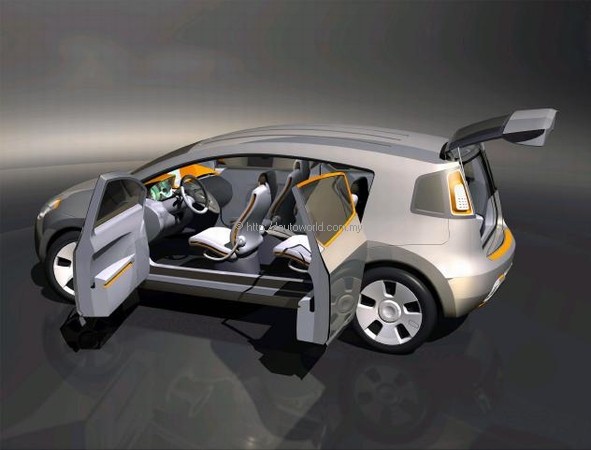Kia Shows A Slice of the Future
Automotive designers have lots of ideas for future cars but are uncertain how consumers will perceive them and more importantly, whether they will be accepted. Most critical are styling concepts which can ‘make or break’ a future model in the marketplace.
For this reason, concept cars have been built for decades to get feedback on certain ideas. Sometimes the styling may be outrageous but it is in the details that the designers really want the public comment, eg the shape of the headlights or the presentation of the rear end.
The Korean manufacturers, fast becoming a force to be reckoned with, are no different and each motorshow sees most of them displaying something futuristic. The latest from Kia is the KCD-1 Slice, said to be a ‘fresh interpretation of the “crossover vehicle.”
“This vehicle is designed to pick up lumber from the home centre one day and to have fun on twisty roads the next,” said Eric Stoddard, a member of the US-based Hyundai-Kia Design Centre designer responsible for the vehicle’s exterior. “We gave it all the cargo-carrying versatility of an SUV without the handling and fuel consumption penalties.”
While some early crossover designs sacrificed either attractive styling or load-carrying ability, the Slice does neither. Instead the vehicle stylish like an international sport sedan, while seating up to six adults. In addition the flexible seats fold to offer cargo space or recline, offering a number of variations for hauling people and stuff.
The wide faired headlights and narrow grille flanking a tasteful badge give the vehicle an appealing visage. Viewed from the side, the Slice features a character line that extends from the front wheel arch to the rear wheel arch. At the same time the very fast windshield angle continues in one arc to form the roofline. A slight kick in the roof over the rear hatch opening gives the vehicle a sporty look.
Other distinctive elements include a subtle, tapered indentation above the rocker panels and the bold dish-type wheels that emphasize the “big wheel” look that helps give the design substance.
“The goal was to create a smooth, clean, sporty exterior highlighted by precise details that seem to be sliced from the materials they are made of,” Stoddard said. “The Slice name, which implies getting to the core by stripping away the extraneous, was a design theme from the beginning.”
One of the key design elements in the Slice concept is its wide, pillarless door openings. All doors are solenoid-operated, allowing for small, well-detailed pushbutton door openers in the window frames. The front doors are conventionally hinged, while the rear doors are hinged at the rear to provide a huge entryway into the vehicle.
“The door openings are very inviting,” said Dragan Vukadinovic, who was responsible for the vehicle’s interior. “Getting into and out of a vehicle easily is of paramount importance to any designer, so the unique door design was a good solution.”
At 2845 mm, the Slice’s wheelbase is almost 150 mm longer than the Kia Optima chassis on which it is based, but its overall length, at 4496 mm, is more than 200 mm shorter. With its big wheels pulled out to the corners aggressively, the concept gives the visual impression of being smaller than it is. Actually, with an overall width of 1829 mm and an overall height of 1.6 metres, the vehicle is very commodious inside.
Excellent interior ergonomics were part of the KCD-1 design parameters from the beginning. The car is a full six-passenger vehicle that doesn’t sacrifice even third-row accommodations to styling considerations. Each seat can comfortably hold an adult, and to enhance comfort and convenience, all seatbelts are integral to the seats, which makes them more convenient to use than pillar-mounted belts. The thin, furniture-inspired seatbacks feature rear “friction pads” that line up with one another when the seats are folded, so the Slice can hold a wide variety of cargo, including long items like wooden planks and skis.
The dashboard, topped with orange as part of the optimistic Slice theme, features its essential instrumentation in a sleek, hooded nacelle. The centre of the dash is dominated by a bold control interface that offers big pushbuttons for the most frequently used controls, and is topped by a pop-up LCD screen for navigation, information or entertainment displays.
The instrument panel design, low cowl and high hip-point seating give driver and front-seat passenger a “command-of-the-road” position. The smoothly contoured centre console, which resembles a motorcycle fuel tank, is one of the vehicle’s many storage areas. Others are in the doors and over the rear wheels.
On the safety front, the Slice offers dual front and side airbags, an array of side and side curtain airbags and an electronic airbag deployment system with in-seat sensors. The rigid body encases all passengers in a solid, crush-resistant safety area.
The Slice is powered by a state-of-the-art, aluminium block 2.7-litre DOHC V6 engine. Equipped with multi-port EFI and a dual-mode intake system, the 24-valve engine delivers the kind of low-end torque and high-end horsepower that fits the broad performance requirements of a sporty vehicle, enhanced by Kia’s Sportmatic transmission that provides the driver a choice of fully automatic or manual control gear selection.
The vehicle’s all-independent suspension has been tuned for responsive handling, while retaining good ride comfort. The front suspension uses double wishbones, coil springs and tubular shocks, while the rear suspension is a multi-link design with coil springs and tubular shocks. Stabilizer bars are fitted both front and rear. The final piece of the handling: 235/45R19 sport tyres on 19-inch alloy wheels.
No production plans have been announced for the Slice, but it will travel to a number of North American and international autoshows in the months ahead to test public reaction to its innovative design and wide array of useful features.





























